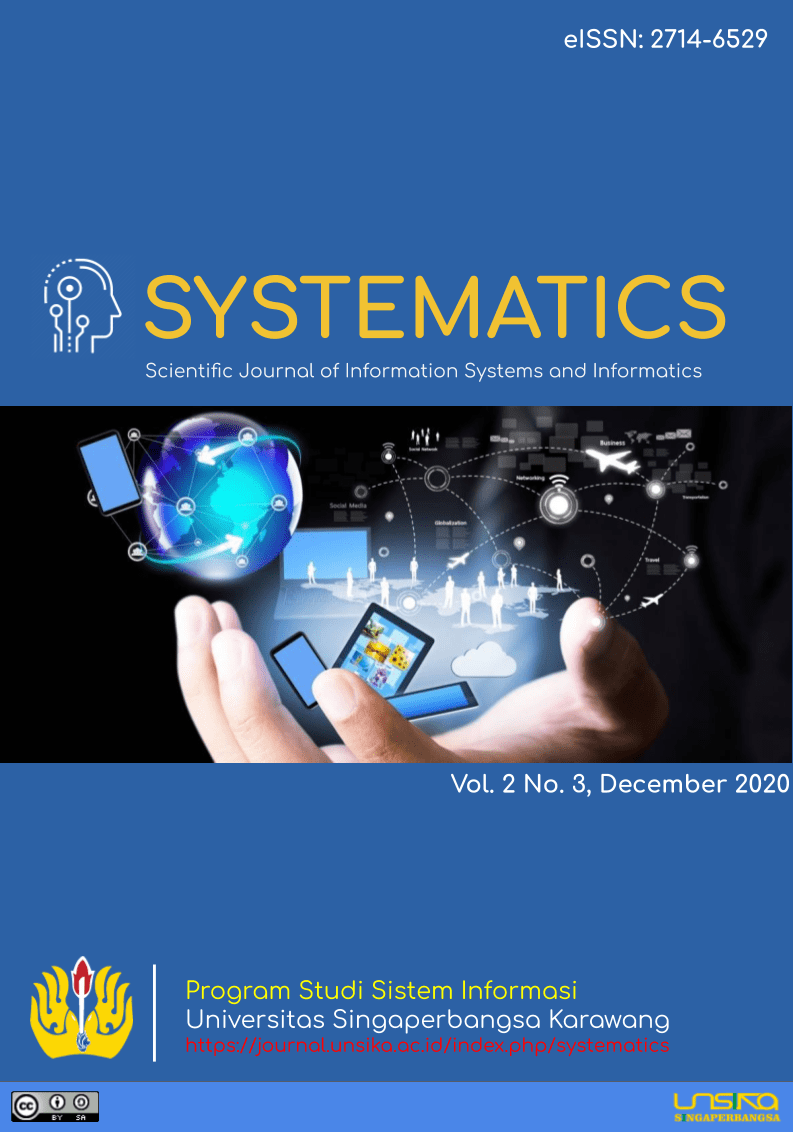Website Implementation with the Monte Carlo Method as a Media for Predicting Sales of Cashier Applications
Abstract
System implementation is a testing process to make it easier for users to carry out the calculation process or process data. by testing it can be concluded whether or not a system is designed. One of them is the implementation of a website-based system to predict sales of cashier applications by applying the Monte Carlo method. Increasing sales of cashier applications currently make developer companies have to prepare quality and feasible software or applications as needed. To maintain an increase in profit, it is necessary to prepare and manage the right human resources. One of them is to simulate to predict future sales of applications by utilizing the Monte Carlo method which has been translated and implemented into a website. From the algorithm, a system implementation is carried out where the calculation process that has been built using Monte Carlo is translated into a website. Website design tools use UML with the PHP programming language and MySQL database. The website is tested and implemented whether the system that has been built is working properly and in accordance with the calculations made previously so that this system can facilitate the simulation process easily and effectively.
Downloads
References
Voutama A, “Perancangan Aplikasi M-Discussion Berbasis Android Sebagai Wadah Diskusi Sekolah,” Vol 7(2), Syntax Jurnal Informatika, 2018, pp.116-124.
Syahrin, E., Santony, J., & Na’am, J, “Pemodelan Penjualan Produk Herbal Menggunakan Metode Monte Carlo,” vol 5(3), Komtekinfo, 2019, pp. 33-41.
Yusmaity, Santony, J., & Yuhandri, Y, “Simulasi Monte Carlo untuk Memprediksi Hasil Ujian Nasional (Studi Kasus di SMKN 2 Pekanbaru),” Vol 1(4), Jurnal Informasi & Teknologi, 2019, pp. 1-6.
Hayati, N., Defit, S., & Nurcahyo, G. W, “Optimalisasi Prediksi Penjualan Produk Herbal Menggunakan Metode Monte Carlo dalam Meningkatkan Transaksi (Studi Kasus: Toko Herbal An Nabawi),” Vol 2(4), Jurnal Informatika Ekonomi Bisnis, 2020, pp. 117-122.
Li, A., Ren, Y., Yang, D., & Li, Z, A “Monte Carlo Simulation Based Algorithm for a Repairable System in GO Methodology.” 5th International Conference on Dependable Systems and Their Applications (DSA), Dalian, 2018, pp. 119-125.
Bertot,L., Genaud, S., and Gossa, J, “An Overview of Cloud Simulation Enhancement Using the Monte-Carlo Method," 18th IEEE/ACM International Symposium on Cluster, Cloud and Grid Computing (CCGRID), Washington, DC, 2018, pp. 386-387.
Eko W.A, Sona P.M, Saputra A.F, &Rolliawati D, “Pemodelan dan Simulasi Antrian Pendaftaran Driver Baru Go-Jek di Sidoarjo.” Vol 17(1), Majalah Imiah Unikom. 2019, pp. 13-18.
Hutahaean H.D, “Analisa Simulasi Monte Carlo untuk Memprediksi Tingkat Kehadiran Mahasiswa dalam Perkuliahan.” Vol 3(1), Journal Of Informatic Pelita Nusantara. 2018, pp. 41-45.
Manurung, K., & Santony, J, “Simulasi Pengadaan Barang Menggunakan Metode Monte Carlo,” Vol 1(3), Jurnal Sistim Informasi Dan Teknologi, 2019, pp 7-10.
Putri, L., Dharmawan, K., & Sumarjaya, “Penentuan Harga Jual Opsi Barrier Tipe Eropa dengan Metode Antithetic Variate Pada Simulasi Monte Carlo,” Vol 7(2), E-Jurnal Matematika, 2018, pp. 71-78.
Fujimoto, R., Bock, C., Chen, W., Page, E., & Panchal, J. H, “Research Challenges in Modeling and Simulation for Engineering Complex Systems.” USA, Georgia Institute of Technology, 2017.
Kirana, M., & D, D. “Simulasi Pengendalian Bahan Baku Produksi Menggunakan Metode Monte Carlo dan Exponensial (Studi Kasus : PT. XYZ),” Vol 7(1), Energy, 2017, 1-6.
Liu J, Shen H, Qi Y, Meng Z.Y, & Fu L, “Self-learning Monte Carlo method and cumulative update in fermion systems.” American Physical Society, 2017, pp. 1-5.
Wagner G, “Introduction to Simulation using Javascript.” Proceedings of the Winter Simulation Conference, 2016, pp. 148-162.
Bain Khusnul Khotimah, “Teori Simulasi dan Pemodelan: Konsep Aplikasi dan Terapan.” Ngimput Purwosari Babadan Ponorogo Indonesia: Wade Grup, 2015, pp. 2-15.
Apri M, Aldo D, & Hariselmi, “Simulasi Monte Carlo untuk Memprediksi Jumlah Kunjungan Pasien.” Vol 7(2), Jurnal Sistem Informasi dan Manajemen. 2019, pp. 32-46.
Mahessya R.A, Mardianti L, & Sovia R, Pemodelan dan Simulasi Sistem Antrian Pelayanan Pelanggan Menggunakan Metode Monte Carlo pada PT Pos Indoensia (Persero) Padang, Vol 6(1), Jurnal Ilmu Komputer, 2017, pp. 15-24.
Voutama A., Novalia E, “Perancangan Aplikasi M-Magazine Berbasis Android Sebagai Sarana Mading Sekolah Menengah Atas,” Vol 15(1), Jurnal Tekno Kompak, 2021, pp. 104-115.
Voutama A., Wahyono D, “Perancangan Aplikasi M-Magazine Berbasis Android Sebagai Sarana Mading Sekolah Menengah Atas,” Vol 2(1), Systematics, 2020, pp. 39-46.
Mubarak A, “Rancang Bangun Aplikasi Web Sekolah Menggunakan UML (Unified Modeling Language) dan Bahasa Pemrograman PHP (Hypertext Preprocessor) Berorientasi Objek,” Vol 2(1), Jurnal Informatika dan Komputer, 2019, pp. 19-25.
Trimarsiah Y., Arafat M, “Analisis dan Perancangan Web Sebagai Sarana Informasi Pada Lembaga Bahasa Kewirausahaan dan Komputer AKMI Baturaja,” Vol 19(1), Jurnal Ilmiah Matrik, 2017, pp. 1-10.
Downloads
Published
How to Cite
Issue
Section
License
Copyright (c) 2021 SYSTEMATICS

This work is licensed under a Creative Commons Attribution-ShareAlike 4.0 International License.
Authors who publish with this journal agree to the following terms:
- Authors retain copyright and grant the journal right of first publication with the work simultaneously licensed under a Creative Commons Attribution-ShareAlike 4.0 International License. that allows others to share the work with an acknowledgement of the work's authorship and initial publication in this journal.
- Authors are able to enter into separate, additional contractual arrangements for the non-exclusive distribution of the journal's published version of the work (e.g., post it to an institutional repository or publish it in a book), with an acknowledgement of its initial publication in this journal.
- Authors are permitted and encouraged to post their work online (e.g., in institutional repositories or on their website) prior to and during the submission process, as it can lead to productive exchanges, as well as earlier and greater citation of published work (See The Effect of Open Access).







